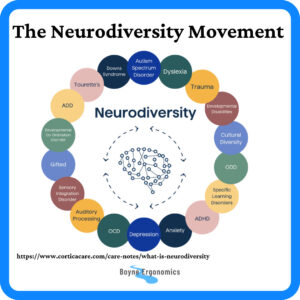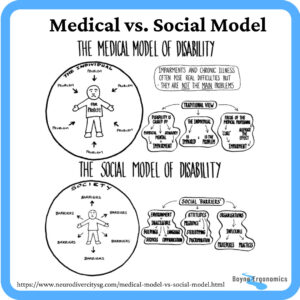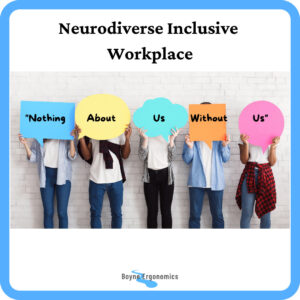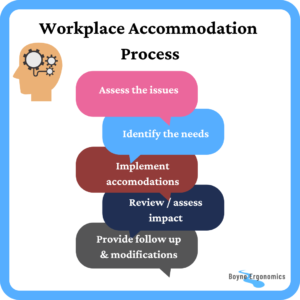As I have previously outlined, ergonomics and human factors is all about designing and optimising tasks, environments and equipment to promote musculoskeletal health and comfort for the user. The user is the focus and human factors professionals, regardless of the field of design and study, will aim to ensure the environment, task and product is designed for ease of use, minimal stress and minimal chance of error.
There is a large focus in the workplace, and rightly so, on ensuring that the physical equipment is suitable for the employees using them. When employees report physical issues with the workplace this can be easily measured and the workplace adapted as required based on symptoms and use.
However, when it comes to neurodivergent employees, the factors that negatively impact their comfort and productivity, can vary so greatly from person to person that it can be overwhelming for all involved when trying to determine what accommodations are required.
The aim of this blog post is to outline what is meant by the term neurodiversity as it pertains to employees in the workplace, some of the challenges neurodivergent employees face in the workplace, what employers can do to address these challenges and the benefits neurodivergent employees can bring to the workplace.
It will provide a general overview, as the symptoms, cognitive abilities, lived experience and accommodations required vary so much across the spectrum of neurological development conditions, and even within the individual subgroups.
What Is Neurodiversity?
Before I get into how neurodiversity can impact employees in the workplace and what employers can do to assist, it is important to understand what is meant by neurodiversity.
The term neurodiversity was first introduced by sociologist Judy Singer in 1998, referring to a group of what she called neurological disorders that affected the females in her family. She suggested the term as a name for the political and civil rights movement that recognises the rights and abilities of all neurotypes.
Neurodiversity is not a diagnosis. As Singer relays in her blogs, no humans are exactly alike and as such the population is neurodiverse.
When we discuss supporting and accommodating neurodiverse employees in the workplace, we are referring to supporting employees that have neurological conditions as identified in the Neurodiversity Movement.
It is cited that approximately 20% of the global population have a neurodiverse condition, with higher reported levels among males compared to females, although recent reports indicate that this may be due to differences in external presentation of symptoms and traits.
A 2021 study in the UK by the Office for Statistics found that an autistic person is the least likely to be in work of any other disabled group, with only 21.7% of autistic people in employment.

The term neurodivergent is a non-medical term that refers to a person with neurological development that is considered atypical or extreme. Examples of neurological conditions that are recognised under the Neurodiversity Movement include Autism, Asperger’s syndrome, Dyslexia, Dyscalculia, Hyperlexia, Dyspraxia, ADHD, OCD, Language delay, Tourette syndrome, Dysgraphia among others.
Autism, or Autism Spectrum Disorders, are developmental disabilities characterised by restrictive, repetitive behaviours, rigid thinking, social communication difficulties and sensory sensitivity. Asperger’s Syndrome is included under this term.
Dyslexia is a learning difficulty that impacts language development and literacy.
Dyscalculia is a learning difficulty that impacts the ability to understand numbers.
Hyperlexia is characterised in children by the ability to read letters and words at a level much higher than expected for their age.
Dyspraxia is a developmental disorder that impacts movement, motor skills and coordination.
ADHD, Attention Deficit Hyperactivity Disorder, or ADD, Attention Deficit Disorder, refers to neurological conditions caused by malfunction of the neurotransmitter chemicals, dopamine and noradrenaline. They are characterised by poor focus and attention, impulsivity and hyperactivity.
OCD, or Obsessive Compulsive Disorder, is a condition that causes obsessive thoughts and compulsive behaviours.
Tourette Syndrome is a neurological condition characterised by involuntary movements and noises, called tics.
Dysgraphia is a neurological condition characterised by difficulty with writing and copying information.
There are two models used when describing neurodiversity and disabilities in general, the Medical Model and the Social Model.
The Medical Model assumes these differences in neurological development to be disabilities, non-adaptive deficits to be treated.
The Social Model assumes that these differences are normal variations of human neurology and that society should adapt to facilitate these differences.

While these models differ in the viewpoint taken on neurodiversity, both models have their function in identifying neurological conditions and developing the accommodations required to allow people with these disorders to develop and thrive in current society. To put it simply, the Medical Model is used to gain entry into the assessment and diagnosis process. Oftentimes, the diagnosis obtained via the Medical Model is needed to initiate or justify accommodations required in the workplace and other areas, as promoted by the Social Model. The Medical Model is generally black and white – symptoms, assessment, diagnosis, treatment. The Social Model focuses more on the personal lived experience of the person with a neurological disorder and focuses on the diversity and strengths those differences bring.
What Challenges Do Neurodivergent Employees Face In The Workplace?
Whether home working, hybrid working or full time onsite, the neurodivergent employee can face many challenges that can increase stress and anxiety, impact productivity and increase the risk of developing physical discomfort.
Job Applications
The first challenge for some neurodivergent people is accessing employment.
Standard text heavy job advertisements, job descriptions and application processes can be too overwhelming and stress inducing for a neurodivergent applicant. The person may be perfect for the role but struggle to understand the requirement, the role or manage the application process.
Interview Process
The interview process can cause a lot of apprehension in a neurodivergent applicant.
The stress associated with unfamiliar locations, settings, people and uncertainty regarding questions and expectations can place the neurodivergent applicant at a disadvantage to neurotypical applicants. Difficulty managing time or public transport can also be an issue.
Disclosure Anxiety
Employees may not feel comfortable disclosing a neurological condition to their employer. This can be due to fear of negative stereotyping or stigma, social exclusion or bullying from colleagues.
Lack of Consistency
Hybrid working / hot desking usually results in different workstation locations or set up every time an employee is in the office. Time is then spent adjusting and familiarising themselves with the workstation. This can cause stress if they cannot get comfortable with the adjusted equipment or they are getting distracted at certain locations.
Open Plan Offices
Open plan offices can be a source of distraction, overstimulation and stress in the neurodivergent employee. Noise, printers, foot traffic and interactions between colleagues can negatively impact concentration and productivity.
Some can experience sensory sensitivity related to noise and lighting levels.
Mismatch Between Tasks and Abilities
Spreadsheets may be difficult to manage for an employee with dyslexia or dyscalculia, tasks requiring coordination may be difficult for an employee with dyspraxia, repetitive monotonous tasks may not be suitable for an employee with ADHD.
Difficulty Managing Communication
Some neurodivergent employees struggle with social interaction, some may be non-verbal, cannot translate non-verbal cues or jargon / sarcasm.
Written communications can be difficult to understand and decipher, particularly when text heavy.
Some neurodivergent employees may have issues with short-term memory and can struggle to remember information and assigned tasks, especially when delegated ad hoc during meetings or video calls. Long meetings without breaks can result in poor concentration and focus.
Difficulty with Standard Office Equipment
Some neurodivergent employees may have issues with motor-coordination, resulting in clumsiness, difficulties operating office machinery or using a standard keyboard and mouse.
How Employers Make Workplaces More Inclusive to Neurodivergent Employees?
Workplaces that are inclusive and accessible to neurodivergent employees benefit from diversity of thought, creative thinking, abstract thinking, innovation and improved problem solving.
The aim of any inclusivity / neurodiversity policy is to remove barriers to access to employment, minimise distractions or discomfort, enhance comfort, focus and performance and facilitate transition into and through work.

Encourage An Inclusive Workplace
Educating employees about neurodiversity via awareness training and open dialogues will help create an environment where employees feel safe disclosing their neurodiverse conditions or traits. This is the starting point for helping them excel in the areas they are gifted in.
At the same time, it is important that employees do not feel labelled or ‘othered’ in the workplace. E.g the dyslexic employee, the autistic employee etc.
Ensure your organisation has a neurodiversity policy, or has neurodiversity included as part of your inclusion policy. This policy should include actions for inclusion, such as ensuring your Employee Assistance Provider has training in neurodiversity, or workplace mentors for employees with neurodivergent traits and hiring processes that are accessible to neurodivergent applicants.
Accessible Hiring Policy
To ensure job advertisements are more inclusive, organisations should also advertise on image based platforms, such as Instagram etc.
In job descriptions, split the role into clearly identifiable necessary skills and desired skills. Keep the format clear and concise.
Be open to alternative application processes, such as video or image based applications.
If using an online application form, ensure it can be spelling and grammar checked before submission.
If your organisation uses psychometric testing, review if these are necessary for the application process.
Consider anonymous candidate selection, removing name, gender and age from applications to reduce bias.
Interview Process
To reduce the stress and anxiety caused by the standard interview process, organisations should consider the following accommodations:
Offer alternatives to standard interviews, such as presentation, trial or short placement.
Ask the applicants if they would benefit from the following accommodations:
Seeing the questions in advance
Additional time to read or prepare
Clear directions to the interview location
Advance viewing of the interview location
Alternative interview location
Alternative interview time that avoids peak commuting times
Preparatory phone call in advance
Bringing another person to the interview
During the interview, ask clear direct questions.
Employee Onboarding
All new starters should have a clear and structured discussion about the expectations of their role and the functional, emotional and social requirements for them to meet these expectations. Ensure all new starters are aware of the supports available to them, including workplace adjustments, assistive technologies and software.
Any workplace accommodations or assistive technology should be discussed with the employee, and not assumed or imposed. The best person to determine their needs is the person themselves.
Ensure all new staff are given a tour of the workplace, including locations of key areas and are introduced to all team members, mentors, HR and any their point of contact for work related issues.
Employee Retention
Organisations that are not inclusive may find it difficult to retain neurodivergent employees.
This can be because these employees experience excessive stress and anxiety due to lack of disclosure, lack of understanding, difficulties with the tasks, lack of integration with their team, bullying, lack of accommodation and lack of progression.
To help foster neurodiversity in the workplace and that neurodivergent employees can be productive, valued and excel, organisations should aim to:
Ensure that employees have personal development plans that are reviewed quarterly
Create career progression paths that are accessible to all employees
Encourage neurodivergent employees to lead by example and act as role models
Review training provided to ensure employees are supported
Value differences
Conduct and learn from exit interviews
For organisations based in Ireland, IBEC and ICTU have launched the Reasonable Accommodation Passport Scheme. This is a confidential live record of the barrier faced by employees and the accommodations agreed with the employer to overcome these barriers.
Any workplace accommodation process should be participatory and include the following steps:

Examples of Workplace Accommodations for Neurodivergent Employees
Below are some examples of accommodations that organisations can make to help support their neurodivergent employees.
Assistive technologies such as:
- Speech to text software
- Text to speech software
- Transcription software
- Handheld reading devices
- Noise cancelling headphones
- Screen readers
- Alternative inputting devices
- Spell checking and word predicting programmes
- Assistive Listening Systems
- Visual Organisers / Mind mapping software
Short form communications
Written follow up to verbally delegated tasks
Staggered or flexible project deadlines
Working from home full time
Assigned workstations
Flexible work schedule

The key to ensuring that organisations are inclusive of neurodiversity is to provide training to all staff, foster understanding, make sure roles are accessible, roles are clearly defined, accommodations are provided and career pathways are personalised.
Sources
https://www.autismawareness.com.au/aupdate/in-conversation-with-judy-singer
https://neurodiversity2.blogspot.com/p/what.html
https://www.disabled-world.com/disability/awareness/neurodiversity
Neurodiversity in the Workplace | Statistics | Update 2022
https://www.neurodiversityhub.org/resources-for-employers
https://www.employersforchange.ie/Reasonable-Accommodation-Passport-scheme
What is ADHD
Bainbridge, H. Reveal or Conceal? The Pros and Cons of Disclosure in the Workplace.
CIPD (2018). Neurodiversity at Work.
Heasman et al (2020) Discover Autism Research & Employment Report on Adjustments.


